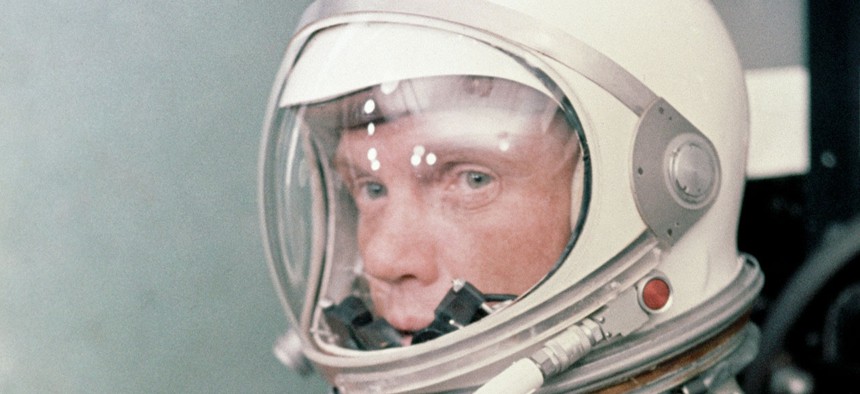
John H. Glenn Jr. dons his silver Mercury pressure suit in preparation for launch in 1962. NASA file photo
Remembering John Glenn
The former senator and first American to orbit the Earth has died at 95.
John Glenn, the lifelong pilot, decorated war veteran, and former senator who became the first American to orbit the Earth during the height of the space race, has died. He was 95.
Glenn died Thursday in his home state of Ohio, a day after news of his hospitalization was reported. He was the last-surviving member of NASA’s first class of astronauts in 1959.
On the morning of February 20, 1962, a 40-year-old John Glenn stepped inside a Mercury capsule, the spacecraft of America's first human spaceflight program, for the Friendship 7 mission. The launch from Cape Canaveral, Florida, was broadcast live on radio and television. “Go, baby!” exclaimed Walter Cronkite several times on air as Glenn, the only person on board, shot into the sky. A year earlier, NASA had successfully Alan Shepard into orbit on a Mercury capsule, but human spaceflight was in its infancy and remained a potentially deadly endeavor. NASA, a fledgling four-year-old agency, believed they'd lose at least one astronaut to one of the Mercury missions. Glenn's capsule was launched on the sixth iteration of the Atlas rocket, and two of the first rockets had blown up.
Glenn entered orbit just fine, and circled the Earth three times, traveling for 4 hours and 56 minutes. He sounded cheerful and calm inside the capsule, making jokes to mission control and thanking the Australians who lit up their homes in greeting as he flew over their continent, as he traveled at nearly 17,500 miles per hour. “Oh, that view is tremendous!” he said in one iconic moment.
But Glenn's return to Earth proved nerve-racking. An indicator back at mission control suggested the capsule's heat shield was loose. Without an operational shield, the spacecraft would burn up during the fiery descent. Shepard instructed Glenn not to deploy the capsule's retrorocket pack, which could help keep the heat shield in place, and to take manual control of the capsule. Glenn described “a real fireball outside” as the Mercury entered the atmosphere—and then splashed safely in the Caribbean Sea, near Turks and Caicos, its passenger unharmed.
Glenn was one of seven men chosen from a pool of 508 candidates for NASA's first class of astronauts, including Shepard, who died in 1998. Glenn's historic flight was an honor, though not the one he had wanted. The astronaut-in-training had sought to be the first American in space, but was assigned as a backup to Shepard, who claimed that title in 1961. But Glenn's voyage came at the height of the space war between United States and the Soviet Union, and his success buoyed the spirits of a watchful American public.
Glenn was born July 18, 1921, in Cambridge, Ohio. He earned a private pilot's license as a young man and joined the Marines during his college years. He flew dozens of combat missions during World War II and in the Korean War. In 1957, he flew a jet from Los Angeles to New York in three hours and 23 minutes, setting a record for transcontinental flight. The trip garnered Glenn a reputation as one of the best test pilots in the country—and an appearance on the popular game show “Name That Tune.” That year, Glenn volunteered for research at the space agency that preceded NASA, and got whirled around inside the high-speed centrifuge that would later prepare astronauts for the rigors of launch and re-entry.
Glenn would return to space once more after his orbital flight, but not for another 36 years. He left the astronaut class two years after his jaunt around Earth and worked for a soft-drink company in Atlanta. President John F. Kennedy, with whom Glenn had formed a close friendship, had other hopes for the astronaut-turned-national hero, and had encouraged Glenn to run for political office. In 1970, Glenn launched his campaign for a Senate seat in his home state of Ohio, but lost. His second attempt in 1974 was successful. During a Democratic primary debate, Glenn's challenger, businessman Howard Metzenbaum, asked him, “How can you run for Senate when you've never held a 'job?’” Glenn responded by pointing to his time in the military and the space program. “It wasn't my checkbook, it was my life that was on the line,” he said.
Glenn served in the Senate until 1999. He ran a short-lived campaign for president in 1983, and was accused and later exonerated in a corruption scandal involving four other senators in the early 1990s.
In the late 1990s, Glenn pitched to NASA the idea of studying the effects of spaceflight on geriatric bodies, and offered himself up as a test subject. In 1998, 77-year-old Glenn flew aboard the shuttle Discovery, becoming the oldest person to fly in space. By then, space agencies knew a lot about spaceflight. The U.S. was ferrying astronauts back and forth through the space shuttle program for missions that lasted up to 10 days. In a few years, when the International Space Station would come online, humans would be spending six months or longer in microgravity.
But researchers owe Glenn for their first taste of the experience of true weightlessness. During his orbit around Earth, Glenn reported back to mission control everything he felt. He measured his blood pressure, tested his vision by reading a small copy of the eye chart found at doctors’ offices, and shook his head around to see if he felt nauseous. He found, much to some scientists’ surprise, that he felt fine.
“In fact,” Glenn later wrote about the experience, “I found weightlessness to be extremely pleasant.”







